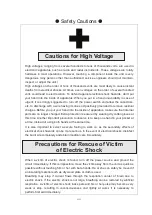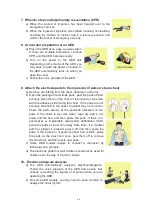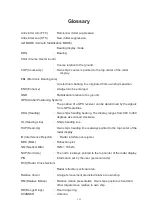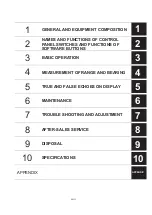
xi
Flow of Cardiopulmonary Resuscitation (CPR)
A person is collapsing.
- Secure the safety of the surrounding area.
- Prevent secondary disasters.
Check for response.
Call while tapping the shoulder.
Recovery position
- Lay the injured or
ill person on
his/her side and
wait for the arrival
of the emergency
services.
Not responding or indeterminate state
Ask for help.
Make an emergency call.
Ask to bring an AED.
Listen to the appeal of the injured
or ill person and give the
necessary first-aid treatment.
Not breathing or indeterminate state
Chest compressions
- With each compression, depress the chest
wall to a depth of approximately 5 cm.
- Perform compressions at the rate of about
100 - 120 times per minute.
Combination of chest compressions and
rescue breaths Note(1)
- If the first-aiders is not trained in rescue
breaths, he/she should perform only chest
compressions. See Note(1) for the details.
Note(1) Combination of chest compressions and
rescue breaths
- If the first-aider is not trained in rescue breaths,
he/she should perform only chest compressions.
- If the first-aider is trained in rescue breath, and has
the skill and will to do it, he/she should perform the
combination of chest compressions and rescue
breaths at the ratio of 30:2. If there is a fear of
infection, he/she should use a personal protective
equipment (mouthpiece for rescue breathing).
Check for breathing and judge for cardiac arrest.
Check for breathing.
Arrival of an AED
Turn on the power.
- Use the AED by following its voice prompts.
Fitting of the electrode pads, etc.
Automatic electrocardiogram
analysis
Do not touch the injured or ill
person.
Electric shock is needed.
Electric shock is not needed.
Delivery of electric shock
Resume CPR from chest
compressions by following the
voice prompts of the AED.
When the injured or ill person
has been handed over to the
emergency services or has
started moaning or breathing
normally, lay him/her on
his/her side in a recovery
position and wait for the
arrival of emergency services.
A person is collapsing.
- Secure the safety of the surrounding area.
- Prevent secondary disasters.
If you call an ambulance, you can get instructions
regarding how to judge cardiac arrest and how to do
cardiopulmonary resuscitation (CPR).
Responding
The AED
automatically
analyzes the
heart rhythm
every 2 min.
When to
stop CPR
Breathing
Содержание JMR-611
Страница 2: ......
Страница 24: ......
Страница 26: ......
Страница 28: ......
Страница 33: ...1 5 1 1 4 EXTERIOR DRAWINGS y Fig 1 1 Exterior Drawing of Scanner Unit Type NKE 387 Unit mm...
Страница 34: ...1 6 Fig 1 2 Exterior Drawing of Processing Unit Type NDC 1774 Unit mm...
Страница 35: ...1 7 1 1 4 EXTERIOR DRAWINGS y Fig 1 3 Exterior Drawing of Operating Unit Type NCE 5923 Unit mm...
Страница 38: ......
Страница 54: ......
Страница 116: ......
Страница 118: ......
Страница 124: ......
Страница 134: ......
Страница 136: ......
Страница 142: ......
Страница 144: ......
Страница 154: ......
Страница 156: ......
Страница 160: ......
Страница 164: ......
Страница 166: ......
Страница 172: ......
Страница 174: ......
Страница 177: ...APPENDIX Fig 1 Block Diagram of JMR 611...
Страница 181: ...APPENDIX Fig 5 Internal Connection Diagram of Control Unit NCM 994...
Страница 182: ......
Страница 184: ......
Страница 186: ......
Страница 187: ......














































